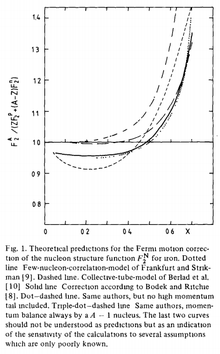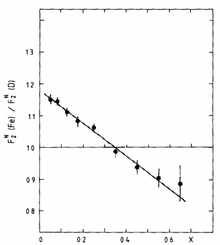EMC effect
The European Muon Collaboration (EMC) conducted high energy particle physics experiments at CERN. In 1983,[1] the EMC described deep inelastic scattering of muons on deuteron and on iron. An analysis showed that the self-volume of nucleon quarks is larger for nucleons of the heavier nucleus. This effect is called the EMC effect and it totally contradicted theoretical predictions published earlier.
The meaning of the results can be briefly outlined as follows. A parameter called Bjorken x is a very useful quantity for describing graphically the data of deep inelastic scattering. The width of the graph reflects the intensity of the quark's Fermi motion at the target. The EMC effect shows that the x-dependence of the ratio of the iron graph to the deuteron graph decreases for an increasing x. This decreasing ratio means that the width of the iron graph is smaller than that of the deuteron graph. Hence, in iron the quark's Fermi motion is smaller than that of the deuteron. Relying on the uncertainty principle, one infers that the self-volume of iron's quarks is larger than that of the deuteron's quarks.
The scientific surprise
The EMC article [1] shows predictions based on quantum chromodynamics (QCD) which had been published before the analysis of the experimental data. These predictions are displayed in fig. 1.

Fig. 1 shows that all these theoretical predictions have similar characteristics, showing that the ratio increases for x > 0.3.
The experimental results published by the EMC are different (see fig. 2) and the graph of the iron to deuteron ratio decreases with an increasing x. Later experiments confirmed this behavior for x > 0.15; for smaller values of x the ratio decreased to 1.0 and below.

Summary
The EMC conclude their report and state: “The results are in complete disagreement with the calculations… We are not aware of any published detailed prediction presently available which can explain the behaviour of these data.”[1]
The EMC effect has been bewildering physicists up to the present day, since there is no consensus explanation accepted by the physics’ community. This situation is described in 2007 article: “So while the experimental signature is clear, the interpretation of this effect is, at present, ambiguous.” [2]
References
- ↑ 1.0 1.1 1.2 J.J. Aubert et al. (1983). "The ratio of the nucleon structure functions F2N for iron and deuterium". Phys. Lett. B 123B: 275–278. Bibcode:1983PhLB..123..275A. doi:10.1016/0370-2693(83)90437-9.
- ↑ J. Arrington et al. (2007). "New Measurements of the EMC Effect in Few-Body Nuclei". J. Phys. Conference Series 69: 012024. arXiv:nucl-ex/0701017. Bibcode:2007JPhCS..69a2024A. doi:10.1088/1742-6596/69/1/012024.